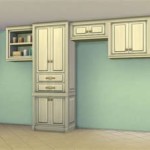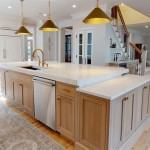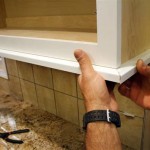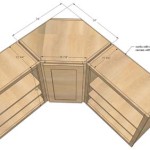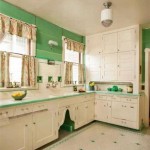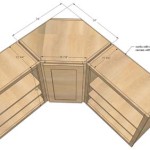Small Corner Kitchen Cabinet Solutions: Maximizing Space and Functionality
The kitchen, often considered the heart of the home, frequently presents spatial challenges, particularly in smaller living environments. Corner spaces, while possessing inherent potential, can often become underutilized or awkwardly formatted areas. Small corner kitchen cabinets offer an intelligent solution to optimizing these otherwise problematic zones, providing valuable storage and enhancing the overall flow and efficiency of the kitchen design.
Corner cabinets are specifically designed to fit into the intersection of two walls, maximizing the available space in a way that standard cabinets cannot. They come in a range of configurations, each designed to address different storage needs and aesthetic preferences. Strategic planning is crucial when incorporating corner cabinets into a kitchen layout to ensure accessibility, functionality, and visual appeal. The selection process should involve careful consideration of the kitchen's dimensions, the homeowner's storage requirements, and the overall design style.
The implementation of small corner kitchen cabinets can significantly impact the organization and practicality of a kitchen. Selecting the right type and configuration is paramount to achieving a space that is both functional and aesthetically pleasing. Proper installation is equally important, as even the most well-designed cabinet can become a source of frustration if not fitted correctly.
Types of Small Corner Kitchen Cabinets
A diverse array of corner cabinet types exists, each offering distinct advantages for different kitchen layouts and storage needs. Understanding the characteristics of each type is essential for making an informed decision.
Lazy Susan Cabinets:
These are among the most popular and efficient corner cabinet designs. They feature rotating shelves, typically circular or kidney-shaped, that allow for easy access to items stored deep within the cabinet. Lazy Susan cabinets are excellent for storing pots, pans, and other large items, as the rotating mechanism eliminates the need to reach into the back of the cabinet. The accessibility they provide makes them a preferred choice for frequently used items.Blind Corner Cabinets:
These cabinets extend into the corner space but have a portion of the cabinet that is inaccessible without a special mechanism. To overcome this limitation, various pull-out systems are available, such as sliding shelves or swing-out mechanisms. These systems effectively bring the contents of the blind corner within easy reach. Blind corner cabinets are a good option when space is limited and maximizing storage volume is a priority.Corner Drawers:
This innovative design replaces the traditional cabinet door with a set of drawers that conform to the corner shape. Corner drawers offer excellent organization and visibility, as items are easily accessible and visible when the drawers are opened. This design is particularly well-suited for storing smaller items, such as utensils, gadgets, and spice jars. The aesthetic appeal of corner drawers can also enhance the overall design of the kitchen.Angle Front Cabinets:
These cabinets feature a front that is angled at 45 degrees, creating a diagonal space in the corner. Angle front cabinets can be used as either base or wall cabinets and offer a unique design aesthetic. They are often used to display decorative items or house small appliances. While they may not offer as much storage space as other corner cabinet types, they can be a visually appealing and functional addition to a kitchen."L" Shaped Cabinets:
These cabinets are designed to form a right angle, effectively creating two separate standard cabinets that meet in the corner. "L" shaped cabinets are often used when the corner space is relatively small or when the homeowner prefers a more traditional cabinet design. They can be customized with shelves, drawers, or pull-out organizers to maximize storage capacity.Considerations for Choosing the Right Corner Cabinet
Several factors should be considered when selecting the appropriate corner cabinet for a small kitchen. These factors relate to space constraints, storage needs, accessibility preferences, and design considerations.
Kitchen Dimensions:
The size and layout of the kitchen are the most fundamental factors to consider. The available space in the corner will dictate the maximum dimensions of the cabinet. It is essential to accurately measure the corner space and account for any obstructions, such as pipes or electrical outlets. A detailed floor plan will help visualize the placement of the cabinet and ensure that it fits seamlessly into the overall design.Storage Needs:
Determining the specific items that will be stored in the corner cabinet is crucial. This will influence the type of cabinet and the internal organization required. If the cabinet is intended for storing large pots and pans, a Lazy Susan might be the best option. If it is for smaller items, corner drawers or a blind corner cabinet with pull-out shelves may be more suitable. Assessing storage requirements will ensure that the chosen cabinet is functional and meets the homeowner's needs.Accessibility:
Ease of access to the contents of the cabinet is a key consideration. Lazy Susan cabinets and corner drawers offer excellent accessibility, while blind corner cabinets require special mechanisms to bring items within reach. The homeowner's physical abilities and preferences should be taken into account when evaluating accessibility. For example, if the homeowner has mobility limitations, a Lazy Susan or corner drawers may be the preferred choice.Cabinet Material and Finish:
The material and finish of the corner cabinet should complement the existing kitchen cabinetry and overall design aesthetic. Common materials include wood, laminate, and metal. Wood cabinets offer a classic and timeless look, while laminate cabinets are more durable and easy to clean. The finish should be chosen to match the other cabinets in the kitchen or to create a contrasting accent. Factors such as moisture resistance and ease of maintenance should also be considered when selecting the material and finish.Budget:
The cost of corner cabinets can vary widely depending on the type, size, material, and features. Establishing a budget beforehand will help narrow down the options and prevent overspending. It is important to balance cost with quality and functionality to ensure that the chosen cabinet provides long-term value. Obtaining quotes from multiple suppliers and installers is recommended to compare prices and services.Installation and Maintenance of Small Corner Kitchen Cabinets
Proper installation is critical to ensuring the functionality and longevity of small corner kitchen cabinets. A poorly installed cabinet can be difficult to use, structurally unstable, and aesthetically unappealing. Professional installation is generally recommended, especially for complex cabinet types, such as blind corner cabinets with pull-out mechanisms.
Professional Installation:
Hiring a qualified and experienced installer ensures that the cabinet is properly aligned, securely attached to the walls, and functions smoothly. Professional installers have the tools and expertise to handle any challenges that may arise during the installation process, such as uneven walls or hidden plumbing. They can also provide valuable advice on cabinet placement and optimization.DIY Installation:
While DIY installation is possible, it requires a good understanding of carpentry and plumbing, as well as the necessary tools. It is important to carefully follow the manufacturer's instructions and take accurate measurements. DIY installation can save money, but it also carries the risk of errors that could damage the cabinet or the surrounding area. If unsure about any aspect of the installation process, it is best to seek professional help.Regular Maintenance:
To keep small corner kitchen cabinets in good condition, regular maintenance is essential. This includes cleaning the cabinet surfaces, lubricating moving parts, and inspecting for any signs of damage. The frequency of maintenance will depend on the type of cabinet and the level of use.Cleaning:
The cabinet surfaces should be cleaned regularly with a mild detergent and water. Avoid using abrasive cleaners or harsh chemicals, as these can damage the finish. For wood cabinets, a furniture polish can be used to maintain the luster and protect the surface. Spills and splatters should be cleaned up immediately to prevent staining or damage.Lubrication:
Moving parts, such as hinges, drawer slides, and Lazy Susan mechanisms, should be lubricated periodically with a silicone-based lubricant. This will ensure smooth and quiet operation and prevent premature wear. Avoid using oil-based lubricants, as these can attract dust and grime.Inspection:
Regularly inspect the cabinet for any signs of damage, such as loose screws, cracks, or water damage. Address any issues promptly to prevent them from escalating. Tighten loose screws, repair cracks with wood filler, and address water damage by identifying and fixing the source of the leak.By selecting the right type of corner cabinet, carefully considering space and storage needs, and ensuring proper installation and maintenance, homeowners can effectively maximize the functionality and aesthetic appeal of their small kitchens.
11 Corner Kitchen Cabinet Ideas For Storage Solution
11 Corner Kitchen Cabinet Ideas For Storage Solution

Pin On New Home

Corner Kitchen Cabinet Low Cost Good Where To Buy

29 Corner Kitchen Cabinet Ideas To Optimize Your Layout Coco Lapine Designcoco Design

Living Skog Corner Pantry Cabinet Kitchen Storage With Microwave Stand Hutch Design Glass Door 23 67 X 36 19 73 Inch Espresso Com

17 2 In W X D 31 5 H Grey Mdf Ready To Assemble Floor Corner Kitchen Cabinet With Adjustable Shelves T291467aae The Home Depot

46 Corner Kitchen Cabinets Ideas That Optimize Your Space Part Diy Remodel Storage Small Cabinet Design

10 Best Corner Kitchen Cabinets Plus 12 Of Clever Ideas

J Collection Mancos Glacier White Shaker Assembled Wall Diagonal Corner Kitchen Cabinet 24 In W X 30 H 14 D Dswa2430 L R Mn The Home Depot
Related Posts

